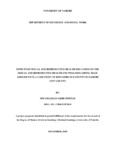| dc.description.abstract | Adolescence refers to a stage of human growth where young person acquires the skills, knowledge, and attitudes required to be sexually active. In the previous decade, the topic of adolescent sexual and reproductive health has been a major focus for many policy makers, researchers, and experts in public health. This study sought to find the sexual and reproductive health (SRH) education male adolescents were provided with. Specifically, what kind of SRH information they received, the sources of this information, the topics of discussion they had, SRH concerns they had that affect male adolescent sexuality. It also explored the available services and information to male adolescents so as to assist them have a good knowledge of their SRH. The broad objective of the investigation was to examine the effect of SRH education among male adolescents and the actions they take to maintain their SRH and wellness. Specifically, the research sought to identify sources of information for SRH among male adolescents, to establish the level of adequacy of knowledge gained from sexual and education, to determine the types of SRH services offered to males adolescents in Nairobi county as well as to show the effects the SRH education had on the male adolescents sexual together with reproductive health outcomes. Descriptive survey design research method was employed in this research. It was employed in the process of gathering data in order to answer questions touching on the relationships of sexual education, knowledge, and information with SRH wellness amongst male adolescents. A sample of 120 respondents aged 18-24 years was selected using simple random sampling technique. Further, 10 respondents were also interviewed as key informants. Research instruments included use of structured questionnaires and key informant interview questionnaire. Quantitative data was analysed using Microsoft Excel. Qualitative data was transcribed and content analysis was carried out. Results were shown in charts, graphs, tables, and narrative form. The study established that male adolescents had some form of sexuality education which they acquired from different sources including the peers, internet, parents, and topics taught in school. The study established that the most preferred sources of information were the internet as it was seen as confidential, parents and medical personnel. The study also established that they had several concerns on their sexual health such as on puberty, sexual development, dating and sexual function/dysfunction. Yet despite all these concerns, only 33% knew where to seek SRH services. The male adolescents also acknowledged that SRH education was important for their sexual health decision making. To improve SRH care, prevention of pregnancy and HIV and STI’s needed to be addressed. The study established that male adolescents were able to cite different correct methods for preventing pregnancy including use of contraceptives, use of condoms, abstinence, the withdrawal method and using the safe day’s method. The male adolescents were also able to state several correct methods of preventing sexually transmitted infections. Those stated included using condoms, avoiding unsafe sex, abstinence, avoiding multiple sexual partners and knowing one’s HIV status. From the study results, it was suggested that male adolescents need to be specifically targeted for SRH education and services. Youth friendly clinics should adequately sensitise communities on the need for male uptake of SRH services. The findings also indicated that the male adolescents had a positive attitude towards receiving and learning SRH information and schools can take this to their advantage to have comprehensive sexuality education specifically geared towards males. Older males and parents need be a support system that male adolescents can rely on to obtain reliable information concerning SRH. The study concludes that Comprehensive SRH Education for male adolescents should be given more emphasis as it has many positive effects and will greatly influence both male and female sexual and reproductive health | en_US |



